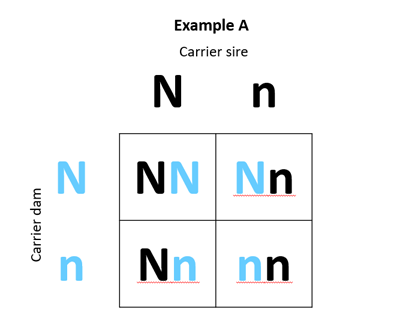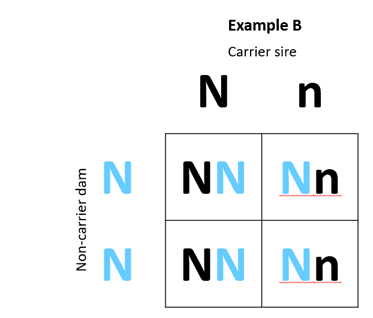DNA Requirements and Rules
- ET Calf, AI Sire, and Donor Dam Requirements
- Genetic Condition Requirements & Genetic Holds
- Outside Labs Test Reporting
- Genetic Conditions
Embryo Transfer (ET) Calf DNA Requirements
All purchased embryos must be parent-verified to both the sire and dam in order to be eligible for registration. Both sire and donor dam must be approved in Herdbook prior to registering progeny. Embryos Registered Under Donor Dam’s Membership Account ET calves being registered by a member who owned the donor at time of flush are not required to have parent verification testing, although it is highly recommended.
Natural Service Sire, AI Sire, and Donor Dam DNA Requirements
All AI sires, natural service sires (born on or after January 1, 2025), and donor dams must have the GGP-100K genomic panel on file to be approved for use within ASA. The GGP-100K is ASA’s minimum requirement for all sires and donor dams, and failing to meet this requirement will prevent the registration of their progeny. Because of the high impact that sires and donor dams have on the population (current or potential), it’s important to have as much genomic information on them as possible.
In addition to the GGP-100K panel, all sires and donors must be tested for any genetic conditions for which they are at risk. ASA tracks for seven of these: NH, AM, CA, PHA, DD, OS, and TH. To view an animal’s individual risk for these defects based on their pedigrees, and to determine if additional testing is needed, go to the animal’s TraitTrac in Herdbook.
Contact ASA's DNA Department at dna@simmgene.com with any questions or test requests.
Deceased Herdsire and Donor Dam Policy
A policy is in place for members wishing to register calves that are progeny of deceased herdsires (born on or after January 1, 2025) or donor dams that did not meet DNA testing requirements prior to death.
Members must contact the ASA DNA Department to learn more about this policy and the steps required before proceeding with registration.
For more information or assistance, please reach out to the DNA Department at 406-587-4531 or dna@simmgene.com.
Genetic Condition Testing
ASA now offers an easy, straightforward way to track genetic conditions in your herd through TraitTrac! Simply search for the animal in Herdbook using their ASA registration number, then select “Genetic Detail” in the “Reports” box below the pedigree to view which conditions an animal may be at risk for based on their pedigree. ASA tracks for seven conditions by pedigree (NH, AM, CA, PHA, TH, DD, and OS), all of which have the potential to place an animal on genetic hold (GH) if they are deemed a population risk. In addition to the genetic conditions reporting, TraitTrac also reports testing and risk for the red gene, diluter, horned/polled/scurred gene, and more!
ASA requires all sires and donor dams be tested for genetic conditions. If a sire or donor dam contains one-eighth of a suspect breed population (e.g., Angus is automatically tracked for NH, AM, and CA) and is designated a population risk or carrier, that animal must be tested for all flagged conditions listed in TraitTrac. Regardless of the results of the testing, the animal’s record will be updated after testing, progeny will be eligible for registration, and certificates will be issued.
For any natural calf (not an embryo) placed on a genetic hold, the condition risk is always tracked from the sire’s side. ASA recommends genetic condition testing as far back on the sire’s pedigree as possible — this not only potentially clears the calf placed on a genetic hold, but can clear generations before it as well. For any embryo transfer (ET), both the sire and donor dam must be tested for any tracked conditions.
Genetic Holds
When an animal is placed on a genetic hold (GH), ASA will not issue/release registration certificates, allow transfers, or update performance data. To remove the hold, members must meet one of two conditions:
- If the sire and/or donor dam is registered with another breed association, the member can request the test results on the parent(s) carrying the genetic condition(s) be sent to ASA. GH will be automatically removed upon completion of condition testing, or proof from another breed association of testing to clear the pedigree. Every breed association is slightly different in how they report animals that are carriers or documented free from conditions. The DNA team may need to reach out to the respective association for clarification before any updates are made.
- If DNA is not available on the sire and/or donor dam that is tracked for the genetic conditions, each progeny must be tested before registration certificates and EPD are released.
Results Key
All the traits and conditions tracked under ASA’s TraitTrac reporting are recessive. This simply means that an animal must inherit two copies of the mutation, one from the sire and one from the dam (i.e., in order to have a calf express the condition, both parents must be carriers). While genetic holds and condition tracking can be inconvenient and frustrating, the technology we use today helps prevent offspring with population risk conditions — or worse, lethal mutations. The testing results you may see are as follows:
Tested Free (TF) – This animal does not carry the genetic condition and will not pass the condition on to their offspring.
Tested Carrier (TC) – Animal has one copy of the genetic mutation and one copy of the normal gene. Half of their progeny will inherit the genetic condition gene. For recessive conditions, an animal needs two copies of the gene to display the phenotype.
Tested Homozygous Carrier (HC) – Extremely rare with genetic conditions, this result is much more common with traits like horned/polled. A homozygous carrier means the animal carries two copies of the genetic condition mutation. Homozygous carriers are possible in non-lethal conditions like Developmental Duplication (DD) or Contractural Arachnodactyly (CA); however, homozygous carriers will always pass on the mutation to their offspring.
*If you think you have a calf that is expressing a genetic condition, please contact ASA.
My sire or donor dam just tested as a carrier for a genetic condition…now what?
This is not a dead end! It’s not uncommon for an animal to come back as a tested carrier for a condition. This simply means the pressure is off the carrier parent for testing, but all subsequent progeny will need to be tested since they now run a proven risk of being a carrier.
Outside Labs Test Reporting
DNA tests for simple traits and genetic conditions can be done outside of ASA. In order for the results to be added on Herdbook, members can forward official results (including registration numbers) from the lab to dna@simmgene.com. Results without registration numbers will experience delays.
Email: dna@simmgene.com Phone: 406-587-4531
Genetic Conditions
Known as “Curly Calf Syndrome,” AM results in stillborn calves small in size with diminished muscling, bent limbs, and twisted spines.
Recessive, lethal, affecting Angus and Angus-influenced cattle.
A genetic mutation is a change in the genetic code from what previously existed. While some genetic mutations are advantageous (polled, for example), the majority of mutations in nature tend to hinder a population’s success via harmful or lethal means. Mutations of this nature are often referred to as genetic conditions or genetic defects.
Dominant mutations always influence an animal’s phenotype so the mutation can easily be selected for or against. Recessive mutations, however, tend to exist in a population even when harmful to the point of being lethal. This is because animals can carry the recessive gene without showing any signs of it. When carrier animals are mated to other carriers, the resulting offspring have a chance of showing symptoms. Fortunately, technology has evolved to the point at which animals that appear normal yet are carriers of recessive genetic conditions can be identified if a DNA test exists for that mutation.
A 2 x 2 Punnett Square can be used to illustrate the outcomes of various matings. In Example A below, we have mated a carrier sire to a carrier dam, while in Example B we have mated a carrier sire to a non-carrier dam.


